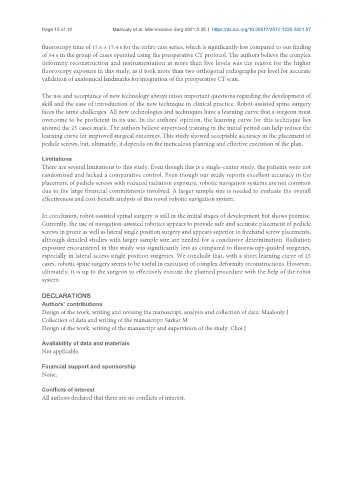Page 344 - Read Online
P. 344
Page 10 of 12 Maalouly et al. Mini-invasive Surg 2021;5:35 https://dx.doi.org/10.20517/2574-1225.2021.57
fluoroscopy time of 17.6 ± 17.4 s for the entire case series, which is significantly less compared to our finding
of 54 s in the group of cases operated using the preoperative CT protocol. The authors believe the complex
deformity reconstruction and instrumentation at more than five levels was the reason for the higher
fluoroscopy exposure in this study, as it took more than two orthogonal radiographs per level for accurate
validation of anatomical landmarks for integration of the preoperative CT scan.
The use and acceptance of new technology always raises important questions regarding the development of
skill and the ease of introduction of the new technique in clinical practice. Robot-assisted spine surgery
faces the same challenges. All new technologies and techniques have a learning curve that a surgeon must
overcome to be proficient in its use. In the authors’ opinion, the learning curve for this technique lies
around the 25 cases mark. The authors believe supervised training in the initial period can help reduce the
learning curve for improved surgical outcomes. This study showed acceptable accuracy in the placement of
pedicle screws, but, ultimately, it depends on the meticulous planning and effective execution of the plan.
Limitations
There are several limitations to this study. Even though this is a single-center study, the patients were not
randomized and lacked a comparative control. Even though our study reports excellent accuracy in the
placement of pedicle screws with reduced radiation exposure, robotic navigation systems are not common
due to the large financial commitments involved. A larger sample size is needed to evaluate the overall
effectiveness and cost-benefit analysis of this novel robotic navigation system.
In conclusion, robot-assisted spinal surgery is still in the initial stages of development but shows promise.
Currently, the use of navigation-assisted robotics appears to provide safe and accurate placement of pedicle
screws in prone as well as lateral single position surgery and appears superior to freehand screw placements,
although detailed studies with larger sample size are needed for a conclusive determination. Radiation
exposure encountered in this study was significantly less as compared to fluoroscopy-guided surgeries,
especially in lateral access single position surgeries. We conclude that, with a short learning curve of 25
cases, robotic spine surgery seems to be useful in execution of complex deformity reconstructions. However,
ultimately, it is up to the surgeon to effectively execute the planned procedure with the help of the robot
system.
DECLARATIONS
Authors’ contributions
Design of the work, writing and revising the manuscript, analysis and collection of data: Maalouly J
Collection of data and writing of the manuscript: Sarkar M
Design of the work, writing of the manuscript and supervision of the study: Choi J
Availability of data and materials
Not applicable.
Financial support and sponsorship
None.
Conflicts of interest
All authors declared that there are no conflicts of interest.

